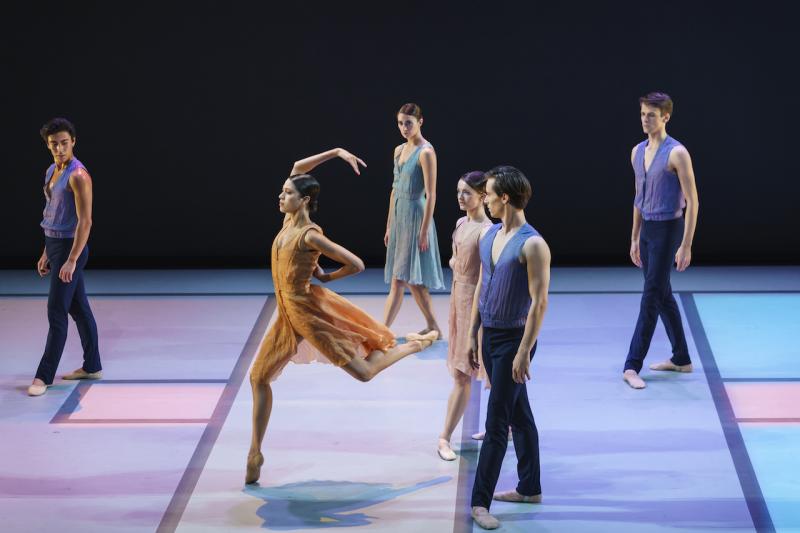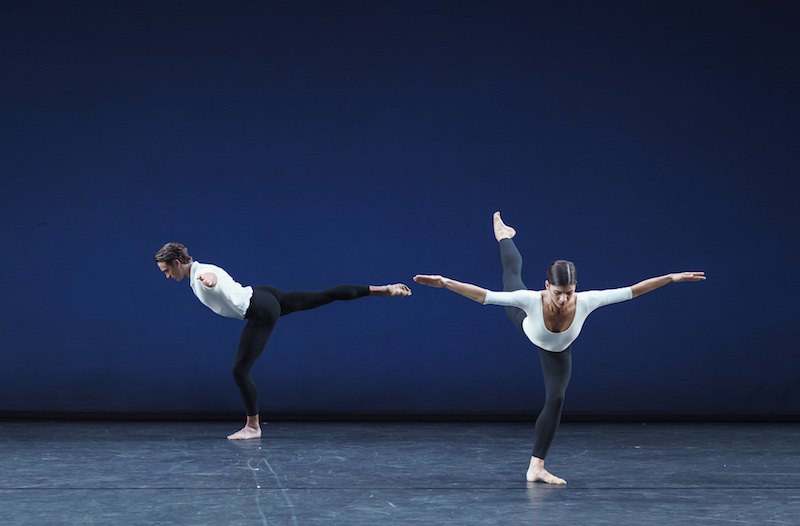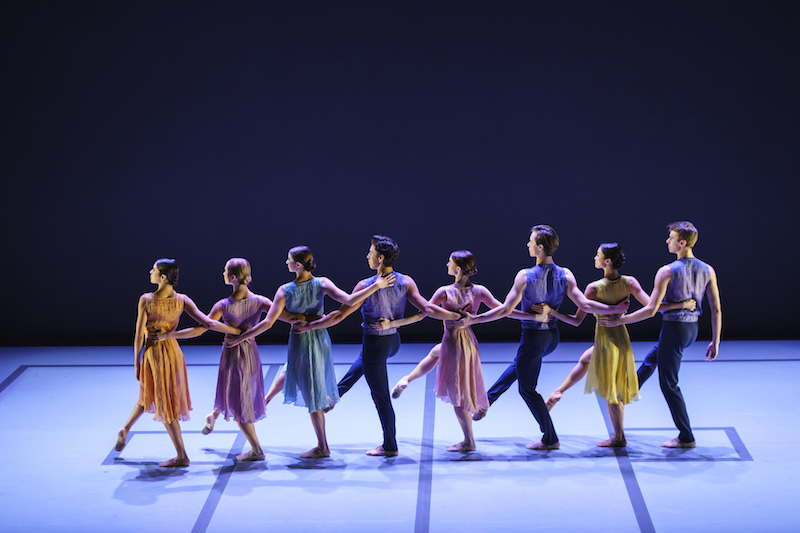Cross Currents/Monotones II/Everyone Keeps Me, Linbury Theatre review - the Royal Ballet finds the missing link | reviews, news & interviews
Cross Currents/Monotones II/Everyone Keeps Me, Linbury Theatre review - the Royal Ballet finds the missing link
Cross Currents/Monotones II/Everyone Keeps Me, Linbury Theatre review - the Royal Ballet finds the missing link
In exploring the road not taken, the Royal Ballet turns up treasures old and new

This programme of three short works is all about influence, specifically the supposed cross currents between ballet and contemporary dance in the latter half of the 20th century.
Still, better late than never. This trio of ballets – a compact, early-ish work by Cunningham, a contemporaneous one by Frederick Ashton, and a world premiere by New Yorker Pam Tanowitz – suggests a route the Royal Ballet might have followed but didn’t. Cross Currents, a compact trio from the early 1960s, foregrounds Cunningham's USP – the divorcing of dance from music. Here, typically, the two elements are set running like trains on different tracks. The three dancers, serenely intent on the steps’ inner rhythms, appear oblivious to the manic jangle of Conlon Nancarrow’s player-piano score.
 Frederick Ashton is said to have composed his luminous Monotones II while under the influence of Cunningham's first London performance in 1965, but otherworldly is about as far as that influence goes. The piece is firmly wedded to the gentle plod of Erik Satie’s piano Gymnopédies, for all that its movement is so smooth and seamless. For where Cunningham was all about process over product, Ashton was a sucker for beauty, and the notion of ungendered dance was anathema. These three performers may be dressed like sexless inhabitants of planet Zorg, but the two guys’ every move is about glorifying the ballerina – heck, they even lift her above their heads as if enthroning her. Happily Gina Storm-Jensen, supremely poised in unforgiving neck-to-toe white Lycra, is every bit worth their attention.
Frederick Ashton is said to have composed his luminous Monotones II while under the influence of Cunningham's first London performance in 1965, but otherworldly is about as far as that influence goes. The piece is firmly wedded to the gentle plod of Erik Satie’s piano Gymnopédies, for all that its movement is so smooth and seamless. For where Cunningham was all about process over product, Ashton was a sucker for beauty, and the notion of ungendered dance was anathema. These three performers may be dressed like sexless inhabitants of planet Zorg, but the two guys’ every move is about glorifying the ballerina – heck, they even lift her above their heads as if enthroning her. Happily Gina Storm-Jensen, supremely poised in unforgiving neck-to-toe white Lycra, is every bit worth their attention.
It’s left to newcomer Pam Tanowitz to justify the programme’s title. She had been quietly making work with her own company in New York for 20 years when she had an international hit with Four Quartets, seen earlier this year at the Barbican, and the equal influence of Cunningham technique and ballet’s airy grace was clear. Everyone Keeps Me is smaller scale, but just as compelling for the way it focuses the gaze on exquisite details, for its sly humour and immaculate composition, made up of steps and gestures that are in no way outlandish but feel new-minted. In a repeated pirouette a girl raises one hand and deploys it in just the same way as a classical fouettée deploys the foot. The effect is of a cheery wave – joyful and witty.
 For this choreographer, communication is key, but not just with the audience: the dancers look at each other, rarely at us. This creates a sense of intimacy, of a circle of interlocking friendships, but far from locking us out, it draws us in, intrigued. At one point Calvin Harris reels off a complicated solo with his back to us, then pauses to catch his breath. Glancing over his shoulder before setting off again it’s as if he has only just realised that anyone was watching.
For this choreographer, communication is key, but not just with the audience: the dancers look at each other, rarely at us. This creates a sense of intimacy, of a circle of interlocking friendships, but far from locking us out, it draws us in, intrigued. At one point Calvin Harris reels off a complicated solo with his back to us, then pauses to catch his breath. Glancing over his shoulder before setting off again it’s as if he has only just realised that anyone was watching.
In Tanowitz’s post-modern aesthetic almost nothing is off-limits, just as Ted Hearne’s string quartet score includes almost every kind of sound a bow can make on a string. At one moment a girl is engaging in a delicate hornpipe, all buoyant and vertical, the next, dancers are rolling like spilled pencils across the floor. The spirit of folk dance and community dance is strong, not least at the opening and close as all nine performers (pictured above) advance in a line, arms linked behind their waists. In its warmth of spirit, the piece is a 21st-century update on Jerome Robbins’s Dances at a Gathering and it has the same potential to become a classic. Too bad this 25 minutes of dance heaven was given so few performances. Pam Tanowitz is a precious commodity, and the Royal Ballet should invest, now.
rating
Explore topics
Share this article
The future of Arts Journalism
You can stop theartsdesk.com closing!
We urgently need financing to survive. Our fundraising drive has thus far raised £49,000 but we need to reach £100,000 or we will be forced to close. Please contribute here: https://gofund.me/c3f6033d
And if you can forward this information to anyone who might assist, we’d be grateful.

Subscribe to theartsdesk.com
Thank you for continuing to read our work on theartsdesk.com. For unlimited access to every article in its entirety, including our archive of more than 15,000 pieces, we're asking for £5 per month or £40 per year. We feel it's a very good deal, and hope you do too.
To take a subscription now simply click here.
And if you're looking for that extra gift for a friend or family member, why not treat them to a theartsdesk.com gift subscription?
more Dance
 'We are bowled over!' Thank you for your messages of love and support
Much-appreciated words of commendation from readers and the cultural community
'We are bowled over!' Thank you for your messages of love and support
Much-appreciated words of commendation from readers and the cultural community
 R:Evolution, English National Ballet, Sadler's Wells review - a vibrant survey of ballet in four acts
ENB set the bar high with this mixed bill, but they meet its challenges thrillingly
R:Evolution, English National Ballet, Sadler's Wells review - a vibrant survey of ballet in four acts
ENB set the bar high with this mixed bill, but they meet its challenges thrillingly
 Like Water for Chocolate, Royal Ballet review - splendid dancing and sets, but there's too much plot
Christopher Wheeldon's version looks great but is too muddling to connect with fully
Like Water for Chocolate, Royal Ballet review - splendid dancing and sets, but there's too much plot
Christopher Wheeldon's version looks great but is too muddling to connect with fully
 iD-Reloaded, Cirque Éloize, Marlowe Theatre, Canterbury review - attitude, energy and invention
A riotous blend of urban dance music, hip hop and contemporary circus
iD-Reloaded, Cirque Éloize, Marlowe Theatre, Canterbury review - attitude, energy and invention
A riotous blend of urban dance music, hip hop and contemporary circus
 How to be a Dancer in 72,000 Easy Lessons, Teaċ Daṁsa review - a riveting account of a life in dance
Michael Keegan-Dolan's unique hybrid of physical theatre and comic monologue
How to be a Dancer in 72,000 Easy Lessons, Teaċ Daṁsa review - a riveting account of a life in dance
Michael Keegan-Dolan's unique hybrid of physical theatre and comic monologue
 A Single Man, Linbury Theatre review - an anatomy of melancholy, with breaks in the clouds
Ed Watson and Jonathan Goddard are extraordinary in Jonathan Watkins' dance theatre adaptation of Isherwood's novel
A Single Man, Linbury Theatre review - an anatomy of melancholy, with breaks in the clouds
Ed Watson and Jonathan Goddard are extraordinary in Jonathan Watkins' dance theatre adaptation of Isherwood's novel
 Peaky Blinders: The Redemption of Thomas Shelby, Rambert, Sadler's Wells review - exciting dancing, if you can see it
Six TV series reduced to 100 minutes' dance time doesn't quite compute
Peaky Blinders: The Redemption of Thomas Shelby, Rambert, Sadler's Wells review - exciting dancing, if you can see it
Six TV series reduced to 100 minutes' dance time doesn't quite compute
 Giselle, National Ballet of Japan review - return of a classic, refreshed and impeccably danced
First visit by Miyako Yoshida's company leaves you wanting more
Giselle, National Ballet of Japan review - return of a classic, refreshed and impeccably danced
First visit by Miyako Yoshida's company leaves you wanting more
 Quadrophenia, Sadler's Wells review - missed opportunity to give new stage life to a Who classic
The brilliant cast need a tighter score and a stronger narrative
Quadrophenia, Sadler's Wells review - missed opportunity to give new stage life to a Who classic
The brilliant cast need a tighter score and a stronger narrative
 The Midnight Bell, Sadler's Wells review - a first reprise for one of Matthew Bourne's most compelling shows to date
The after-hours lives of the sad and lonely are drawn with compassion, originality and skill
The Midnight Bell, Sadler's Wells review - a first reprise for one of Matthew Bourne's most compelling shows to date
The after-hours lives of the sad and lonely are drawn with compassion, originality and skill
 Ballet to Broadway: Wheeldon Works, Royal Ballet review - the impressive range and reach of Christopher Wheeldon's craft
The title says it: as dancemaker, as creative magnet, the man clearly works his socks off
Ballet to Broadway: Wheeldon Works, Royal Ballet review - the impressive range and reach of Christopher Wheeldon's craft
The title says it: as dancemaker, as creative magnet, the man clearly works his socks off
 The Forsythe Programme, English National Ballet review - brains, beauty and bravura
Once again the veteran choreographer and maverick William Forsythe raises ENB's game
The Forsythe Programme, English National Ballet review - brains, beauty and bravura
Once again the veteran choreographer and maverick William Forsythe raises ENB's game

Add comment